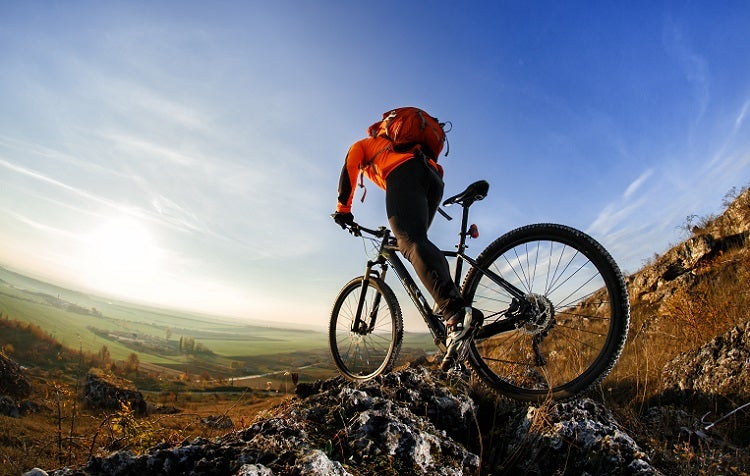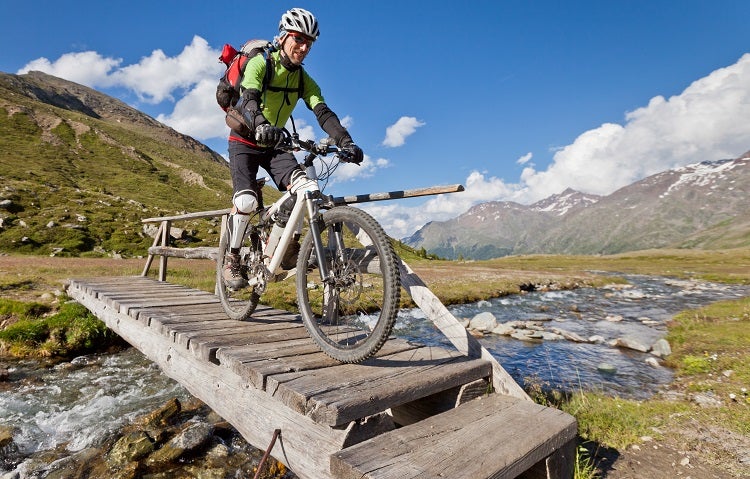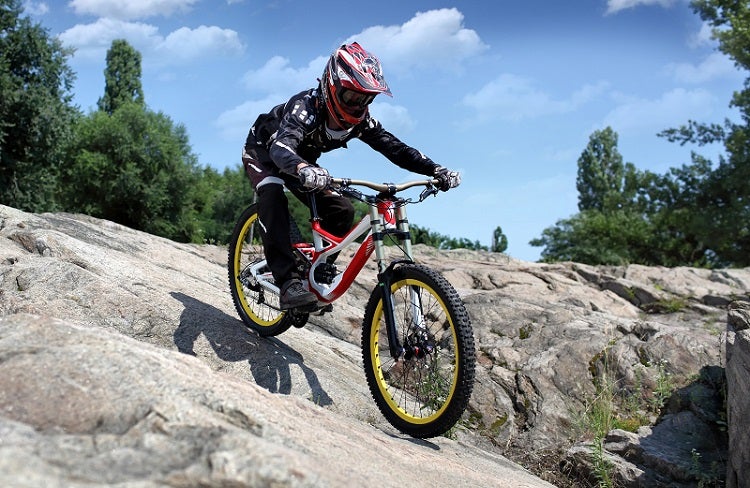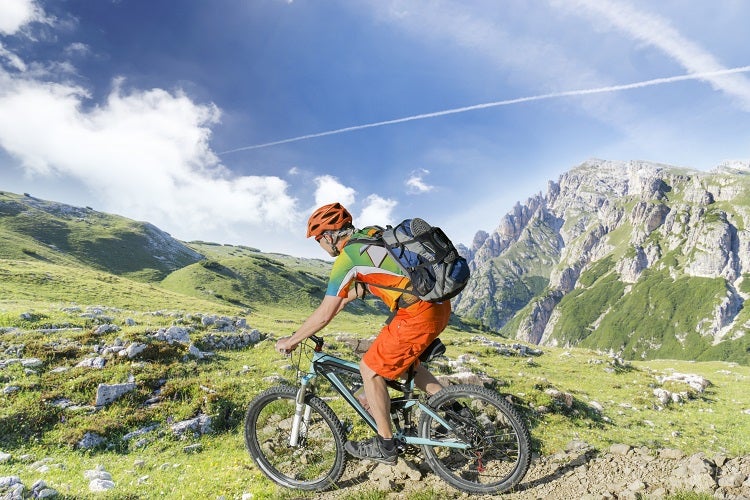
Our Editors independently research, test, and rate what we feel are the best products. We use affiliate links and may receive a small commission on purchases.
MTB backpacks are a necessity for mountain bikers for a number of reasons. The combination of a place to store your gear and ability to carry a large volume of water speaks for itself.
It has also been shown that riding with a hydration packs results in more frequent drinking and better hydration in comparison to using a water bottle. This is because a hose is much easier to reach and use than a water bottle on the frame.
Depending on what kind of riding you do and the distances/time involved, you will need a bigger pack and hydration bladder.
Best MTB Backpacks
| Osprey Packs Raptor Backpack | CamelBak Skyline Backpack | EVOC Low Rider Hip Pack | |
|---|---|---|---|
| Storage: | 14 Liters | 10 Liters | 5 Liters |
| Hydration: | 2.5 Liters | 3 Liters | 2 Liters |
| Waist Belt: | Yes | Yes | Yes |
| Waterproof: | Yes | No | Yes |
For more of my MTB gear recommendations, have a look through these popular Outside Pursuits guide links: MTB Helmets, MTB Pedals, MTB Shoes.
Quick Answer: The 7 Best Rated Mountain Bike Backpacks
- Osprey Packs Raptor Backpack
- Camelbak Skyline Backpack
- EVOC FR Enduro Rucksack
- Deuter Trans Alpine 30
- Dakine Canyon MTB Backpack
- EVOC Low Rider Hip Pack
- Camelbak Classic Hydration Pack
There are many MTB backpacks available with a wide range of volumes and features. Our guide and comparison table of the top rated MTB backpacks will help you choose the right one for you.
MTB Backpack Reviews
#1 Osprey Packs Raptor Backpack
- 14 Liters of storage
- Tool roll, blinker light, magnetic sternum strap
- Full face carry ability, lidlock bike helmet attachment
The Osprey Packs Raptor Backpack is a well-rounded product designed with safety and strength as its top priorities.
With a blinker light attachment and special reflective patch for visbility, this is an excellent choice for those who want to ride on the roads as well as the trails.
The main compartment has 14 liters of storage space, including zippered slash pockets and mesh hipbelt pockets. A lower compartment holds a roll-up tool pouch for more supplies.
Inside, there is a dedicated hydration receptacle with an included BPA-free 2.5L reservoir – perfect for storing snacks and water on your longer trips.
Despite its large size, this pack stays firmly in place thanks to its magnetic sternum strap and side compression feature.
Best For: Bikers who prioritize safety and visibility on the course.
#2 CamelBak Skyline Backpack
- 7 Liters of storage
- 100oz Reservoir included
- Straps for a helmet and pads
There are two versions of this feature filled pack available. The Skyline is for men and the Solstice for women. A 100oz reservoir is included with this mountain bike backpack and there is space inside for 7 liters of gear.
This should be more than enough more most short to medium length rides. There are some nice features included in this pack.
A fleece lined pocket gives you somewhere to store sunglasses without scratching them, there is a pocket that compresses down so you can squash your jacket as small as possible and your helmet and kneepads can be attached to the outside.
The “LR” in the name does not stand for liter, but lowrider and refers to how the pack sits low on your back, moving the weight to your hips.
This keeps the pack stable when riding at speed and the top of your back stays open, helping to keep you cool. Its a tough call, but I think the Skyline is the best MTB backpack.
Best For: A feature filled day pack with male and female specific versions.
#3 Evoc FR Enduro Rucksack
- 16 Liters of storage
- Spine protector
- Tool roll, waist belt
- External helmet and pad storage
Although this pack was built for enduro racers, it will also support you on normal rides as well. The defining features of this pack are its integrated spine protector.
This is a great feature that can protect you in two ways. If you crash, it will stop anything in your pack from stabbing you in the back (literally!).
Likewise, if you land on your back, it will prevent your spine from hyper-extending and causing potentially life changing injuries.
The internal storage capacity is also quite high – able to hold 16 liters of gear, this is a great option for a long day of riding and racing!
You can ride comfortably for many hours wearing this pack thanks to the back padding and comfortable shoulder straps. There is even an airoflex waist belt for added support.
As with all EVOC products, the construction is great and there is a surprising amount of attention to detail.
Best For: Enduro racers and riders who need spine protection.
#4 Deuter Trans Alpine 30
- 30 Liters of storage
- Ventilated straps and back panel, spring steel frame
- 3 liter hydration bladder, external helmet holder
Deuter have done a good job of creating a mountain bike backpack with a large storage capacity that also keeps you cool.
The shoulder and waist straps are constructed with a mesh and the wide channel between the back pads allows air flow.
The whopping 30 liters of storage space has a good shape to let you cram in more gear most packs – great for long rides.
There is a tool pocket on the outside and a detachable rain cover to keep everything dry in wet weather.
This Deuter pack has a large 3 liter hydration bladder and there are loops on each shoulder strap, so you can choose which side to wear the hose.
Most packs do not give you this choice. When fully laden, this pack does have the tendency to move from side to side, even if you pull the straps really tight.
Overall, the Deuter Trans Alpine 30 is the best MTB hydration pack.
Best For: Big days on the mountain while staying cool and refreshed.
#5 DAKINE Canyon Hydration MTB Backpack
- 20 Liters of storage
- Breathable backpanel
- Straps for a helmet and pads
Sometimes you need to take a lot of gear with you. Bikepacking is a great example of when you need extra space in your pack.
The Canyon has 20 liters of storage space to pack in clothing, food, as well as large camping items like a sleeping bag and all the rest of your equipment.
There is a tool roll that unzips from the outside of the pack and smaller side pockets for snacks. A helmet and pads can be strapped on to the outside.
The more you pack in, the heavier the load. Thankfully the Canyon is comfortable to wear when fully packed thanks to the padded and ventilated shoulder and waist straps.
Best For: Riders who do not pack light and bikepackers.
#6 EVOC Low Rider Hip Pack
- 3 Liters of storage
- 1.5 Liter reservoir
- Tool roll
Hip packs are great if you do not like getting a sweaty back. Evoc have designed this hip pack with short rides in mind.
It may look small but a surprising amount of gear can be hidden away inside.
A 1.5L reservoir is included and stows away in its own section next to the 3 liter main compartment. Here you should be able to fit an extra layer or rain jacket and snacks.
There is also a fold out tool roll to organize your tools and make trailside repairs easy. On each side of the waist strap is a pocket big enough for some snacks or your phone.
Evoc knows that you hate sweating. The back features the brand’s special Air Flow Contact Padding.
This helps keep the part of your back in contact with the pack cool and as sweat free as possible.
Once you have it strapped down, the pack does not usually bounce around even when riding through rough terrain.
If you have heavy items in it plus a full reservoir, then you may notice some movement but not enough to bother you.
Best For: Short rides and riders who do not like sweaty backs.
#7 CamelBak Classic Hydration Pack
- 2 Liters of storage
- 70oz Reservoir included
- Lightweight, ventilated mesh harness
CamelBak have a legitimate claim to calling this pack the “Classic”; they made hydration packs popular way before other brands caught on.
CamelBak used to be the only company producing these. Their early monopoly on the market led to their becoming a household name.
The Classic is the first pack that they produced and has been updated to keep in their lineup over the years. There is an included 70oz reservoir and 2 liters of storage space inside for the bare essentials.
You should be able to fit in a jacket and a few snacks, making this pack ideal for short to medium length rides, as well as cross country racing.
There is a compartment on the front for tools and an external bungee to store any layers that do not fit inside.
The wide shoulder straps have vents, making them stable and cool. We said above to look out for waist straps, but this pack does not even need any thanks to its small size!
The Camelbak Classic is the best cycling backpack for short rides.
Best For: Short rides and cross country races.
Mountain Bike Backpack Comparison
| MTB Backpack | Storage | Water Reservoir | Style | Rating | |
|---|---|---|---|---|---|
| Osprey Packs Raptor Backpack | 14 liters | Yes | Backpack | 4.8 / 5.0 | |
| CamelBak Skyline Backpack | 7 liters | 100oz | Backpack | 4.6 / 5.0 | |
| Evoc FR Enduro Rucksack | 16 liters | None | Backpack | 4.7 / 5.0 | |
| Deuter Trans Alpine 30 | 30 liters | 3 liter hydration bladder | Backpack | 4.8 / 5.0 | |
| DAKINE Canyon Hydration MTB Backpack | 20 liters | Hydration internal sleeve | Backpack | 4.8 / 5.0 | |
| EVOC Hip Pack Race Hydration Pack | 3 liters | 1.5 liter | Hip Pack | 4.3 / 5.0 | |
| CamelBak Classic Hydration Pack | 2 liters | 70oz | Backpack | 3.8 / 5.0 |
How to Choose the Best MTB Backpack for You
Storage Volume
The first thing you need to think about is how much gear you take with you on the average ride. Think about extra layers, tools, snacks, extra tires etc.
If you only go on short rides, then you probably only take a few tools whereas all day rides in the mountains require that you take more with you. If you like bikepacking then you need even more space for food and camping equipment.
There are even hydration packs available for photographers to (reasonably) safely transport their equipment.
Reservoir Volume & Quality
How much are you going to drink on your average ride, or how much do you need to take in order to make it to the next water source. The water reservoir in your pack needs to hold this amount of water and also needs to fit in the pack.
If a reservoir comes with the pack, then this is not a problem. Sometimes you will need to buy a reservoir separately so check that your pack will hold what you need.
Unfortunately, not all included reservoirs are of a particularly good quality. If you need to purchase one, do not get the cheapest available as poorly constructed reservoirs have a tendency to leak or even break, which is less than ideal when you are deep in the mountains.
Look for a reservoir with a large opening so you can clean the inside properly. Mold will grow on the inside of any reservoir if you leave it long enough. This can even happen overnight if you have had a sugary sports drink in there.
To help avoid this, keep your reservoir clean and at the least, store it in the freezer in between rides.
Rucksack or Hip Pack
There are rucksack style hydration packs available in a big range of sizes. From small with enough storage for bare essentials to huge bags for bikepacking and photographers.
If you do not like wearing a rucksack and do not need to transport huge amounts of gear or water, then a hip pack is a good choice. They tend to have a smaller storage capacity and carry up to 1.5 liters of water.
This is enough for medium distance rides and you can enjoy the breeze flowing over your back.
The disadvantage is that a hip pack is more prone to shaking around while you ride unless you tighten the straps up as much as possible.
Fit
Like all equipment, a hydration pack needs to be comfortable to wear or you will not enjoy using it.
If a pack moves around or shakes from side to side, not only will you find this annoying, but you will also find that the weight of the pack will pull you off balance in corners with potentially disastrous consequences.
Look for a pack that has lots of adjustable straps to customize the fit and how it sits on your back. The weight of the bag should be spread over your back and supported with a hip strap. Padding on the shoulder straps will help keep you comfortable too.
Additional Features
A well thought out hydration pack will have lots of little extras to make you happy. A dedicated multi-tool compartment will make trailside repairs easier, a helmet strap gives you somewhere to stash a helmet on long ascents and straps allow you to carry pads or camping equipment.
Inside it is useful to have compartments to organize your gear and if a rain cover is included you can get home without everything in your pack getting wet. Some hydration packs have a spine protector and even a whistle for emergencies.
Conclusion
We have written this article to help you navigate the choice and make an informed decision about the right mountain biking backpack for you. Review our criteria for choosing a backpack to see what features are important to you. Then check out our suggestions of MTB backpacks.
I hope this guide was helpful in picking the best MTB backpack to fit your needs. If you want to comment or recommend a pack I didn’t include, please use my contact form to get in touch.
Have fun and be safe out there!
How We Researched
To come up with the top mountain biking backpacks, we researched a variety of sources for reviews such as Competitivecyclist, JensenUSA, REI, EVO along with our own personal experience.
We also consulted online magazines for product research and reviews to get as much unbiased information as we could. To help weed out fake reviews we used Fakespot.com to make sure we only looked at genuine reviews.
With so much quality gear available, we had to narrow it down based on what we felt were the best options were for the price. The author, Richard Bailey has a wide background in mountain biking in a variety of countries, terrain types and bike packing for weeks on end.
The author has decades of experience and is eager to share his knowledge with readers.
To help narrow down the selection we used personal experiences along with recommendations from fellow MTB bikers, bloggers and bike shops.
After extensive research, we came up with our list to help you choose the right one for you.




What do you mean by “100oz Reservoir” I would like to know the volume of liquid not the weight.
For some packs you correctly wrote 1.5 litre for the reservoir volume, but for others you wrote a weight, I am confused by this.
Paul, oz is a measure of volume as well, like a 16oz coke. So if the manufacture says 100oz that’s what I use. You can do an easy google search to convert oz to liters.